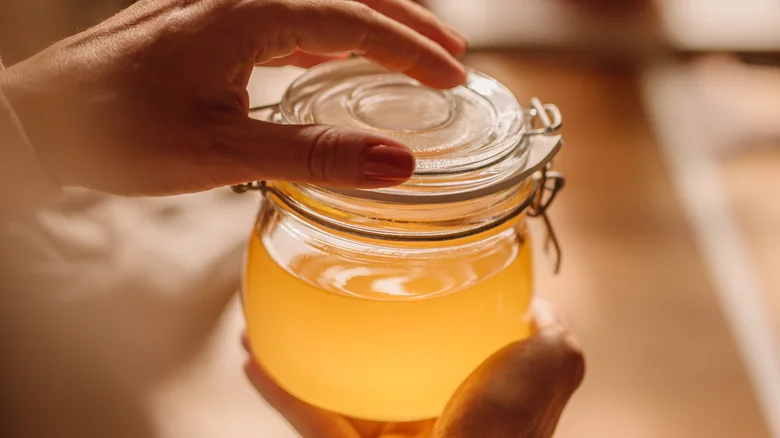Is Ghee the golden elixir of wellness?
- Natural Joy Yoga

- Jun 4, 2024
- 4 min read
First of all, what is ghee anyway? It's a special kind of butter that has been the staple of traditional Indian cuisine for centuries. It is prepared by simmering butter until the milk solids separate and are then strained, leaving behind pure butterfat. The process of making ghee involves heating unsalted butter in a pan over low heat until it melts. As it continues to cook, the water content evaporates, and the milk solids separate and settle at the bottom of the pan. The clarified butter is then carefully strained to remove these solids, resulting in pure ghee. This slow-cooking method enhances the flavor and nutritional properties of the final product.
Although it is somewhat unknown in the Western world, ghee is entering the spotlight in style.
According to Ayurveda, this butter promotes longevity and protects against the development of some diseases. It is believed to lubricate tissues, improve elasticity, enhance memory and stimulate digestion. However, there is concern about the presence of saturated fats in its composition and its possible inappropriate use.
What are the key benefits of ghee?
Broadly speaking, the differences between butter are small. Ghee contains a higher percentage of fat. Therefore, it offers a greater amount of butyric acid and other short-chain fats with interesting effects. It also loses some components such as lactose and milk proteins (including casein). For this reason, it is considered something more digestive. It is recommended to choose the product from grass-fed animals, as its nutrient content may be more positive.
There are advantages related to the presence of fatty acids, such as omega 3, butyric acid and conjugated linoleic acid (or CLA). In addition, it also contains some fat-soluble vitamins (A and E) and antioxidants.
Eating fatty foods can increase the bioavailability and absorption of some vitamins and minerals. In addition, ghee adds new nuances of flavor to dishes, which can be more appetizing.
Clarified butter (Ghee) has a higher smoke point than conventional butter and some vegetable oils. Thus, it is a perfect option for roasting, baking and sautéing at high temperatures without the risk of losing nutrients.
It is worth highlighting the antioxidant and anti-inflammatory activity and the prevention of colonic carcinogenesis (a process by which healthy cells become malignant cells). It also helps improve the defense barrier against pathogens and enhances intestinal transit.
Among other things, thanks to the softening effect on the stomach wall, the consumption of ghee counteracts some ailments such as indigestion, acid reflux or gastritis.
Possible contraindications
60% of the final composition of ghee belongs to saturated fatty acids. Due to this characteristic, there is concern about its possible relationship with an increase in blood cholesterol and the risk of cardiovascular disease.
The main dietary guides and expert associations continue to recommend reducing the consumption of saturated fats to below 6% of total energy. Therefore, it is advisable to use this food moderately and in small quantities.
When ghee should not be used You shoul never mix honey with ghee!
In Ayurveda, both ghee and honey are prized for their positive effects on human health. But combining honey and ghee in equat ratio is a big no-no , as produces a toxic combination. The well-known Ayurvedic text Charak Samhita states that combining equal amounts of honey and ghee can be damaging to one’s health as a toxin known as Clostridium Botulinum is produced and spread throughout the body.
Learn more about the Toxicity profile of honey and ghee, when taken together in equal ratio
Additionally, Ghee should not be consumed by those following a vegan diet, individuals with unbalanced Kapha or Ama (except for Shatpala Ghritam), hepatitis, fatty liver, congestion, fever, obesity, indigestion, and/or diarrhea.
.
Ghee for detoxification and Ayurvedic applications
Ghee is sweet, cooling and pacifies Vata and Pitta. It is often used during cleansing and detoxification and various Ayurvedic therapies.
Do you want to know other uses of Ghee?
Moisturizes the skin, gives it a glow and luster and is excellent for use in abhyanga or self-massage.
Ghee can be used in face packs or for spot treatments and helps with dark spots and dark circles under the eyes.
Heals minor wounds and is great for chapped skin, lips, and dry elbows and heels.
With its antioxidant properties, Ghee helps deliver nutrients to the skin, hair, and scalp.
For pregnant women, ghee is applied below the umbilicus if there is bleeding and can be applied to soothe cracked nipples in lactating women.
~~~~~
Now that you know little bit more about Ghee properties,
Will you start introducing the golden elixir into your daily life?
Sources:
1.Journal of Ayurveda and Integrated Medical Sciences (JAIMS) -https://jaims.in/jaims/article/view/2853/4295
4.Effects of dietary supplementation with ghee, hydrogenated oil, or olive oil on lipid profile and fatty streak formation in rabbits – PubMed (nih.gov)
5.Effects of cow ghee (clarified butter oil) & soybean oil on carcinogen-metabolizing enzymes in rats – PubMed (nih.gov)










Comments